

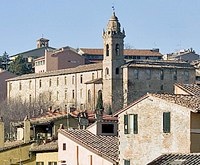
In 1421, a community of Augustinian hermits moved here from Santa Maria del Sasso, Montemalbe, outside Perugia and built the first monastery on this site, which was known as Santa Maria Novella. The complex was subject to the friars of Sant’ Agostino. Their prior, Fra Battista da Gubbio, commissioned their new church.
The Confraternita di Santa Maria della Consolazione met in the crypt of this church until 1500, when it built the Oratorio di Santa Maria della Consolazione in what is now Corso Garibaldi.
The friars moved to Sant’ Agostino in 1641, and ceded this complex to a community of Sylvestrine nuns from San Benedetto (now Sant’ Erminio). It then became known as San Benedetto dei Condotti: the second part of the name refers to the nearby aqueduct. This community was suppressed in 1820, when the few remaining nuns moved to Santa Caterina.
From 1826, the complex housed the Conservatori Graziani, a charity for poor women that was established using a bequest from the Contessa Anna Graziani Baglioni. It was subsequently absorbed by the Congregazione di Carità.
The complex now belongs to the University of Perugia and houses its administrative department (ADISU).
Exterior
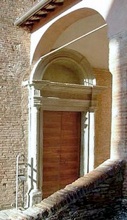
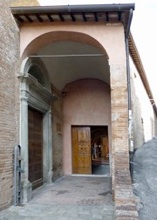
The main entrance to the church is in Via Benedetta.
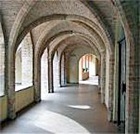
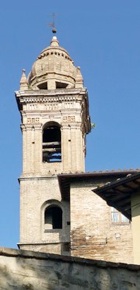
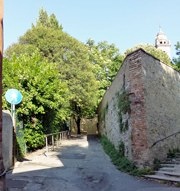

You can continue around the complex by turning sharply right at the foot of the steps to get a glimpse of the apse of the church.
Interior of the Church
The original Latin cross plan was modified by a wall that enclosed the part nearest the apse. The remaining, larger part of the church, which was used for public services, was covered in frescoes.
[Original majolica pavement (15th century)]
Vision of St Brigid of Sweden (15th century)
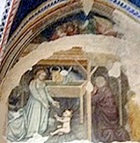
Votive Frescoes (15th and 16th centuries)
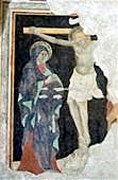
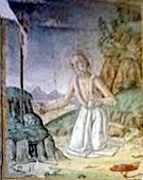

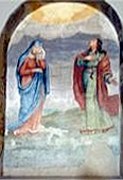
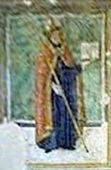

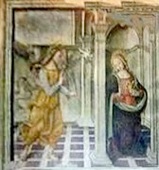
There are a number of important, albeit neglected, frescoes in the church.
Art from the Church
Panels from a Polyptych (early 15th century)
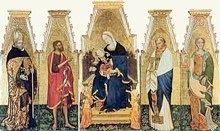
In 1791, Baldassare Orsini recorded the presence of these five panels in Sant’ Agostino. He also reported that:
-
✴two associated predella panels, which depicted the Crucifixion and the martyrdom of St Sebastian, were separately displayed; and that
-
✴the work came from San Benedetto dei Condotti (previously Santa Maria Novella).
The scroll at the foot of the throne in what was the central panel identifies the artist as Lello da Velletri.
It seems reasonable to suppose that the panels came from a polyptych that the hermits from Montemable commissioned for the high altar soon after they moved to Santa Maria Novella in 1421. They probably took the panels to Sant' Agostino in 1641, when Santa Maria Novella was ceded to the Sylvestrines. The main panels entered the Galleria Nazionale in 1863, by which time the predella panels had been lost.
All five panels are set in a flowery meadow, and each has a gold background:
-
✴The central panel depicts the Madonna and Child enthroned with two kneeling angels. The Madonna offers a small bunch of red and white flowers to the Child, signifying the Crucifixion.
-
✴The other panels depict saints whose identities are recorded by inscriptions in the haloes:
-
•St Augustine, whose Rule was followed by the Augustinian hermits;
-
•St John the Baptist, who probably commemorated Fra Battista da Gubbio, the prior who commissioned Santa Maria Novella and whose death possibly preceded the commission of the altarpiece;
-
•St Liberatore, who probably commemorated Fra Liberato di Simone, a monk from the earlier monastery on Montemalbe who was murdered in 1391; and
-
•St Agatha, who holds her severed breasts on a plate.
Crucifixion (ca. 1410)

-
✴the swooning Virgin, the distraught St Mary Magdalene and other women to the left; and
-
✴the weeping St John the Evangelist on a rock to the right.
[Note that the attribution and dating here are suggested by Mauro Minardi, cited on the page on the artist. The Galleria Nazionale dates the work to ca. 1416-20 and attributes it to Lorenzo’s brother, Jacopo Salimbeni.]
Gonfalon della Consolazione (ca. 1496-8)
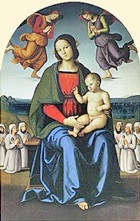
When the confraternity was suppressed in 1797, one of its members hid the banner in his home in order to avoid confiscation by the French. The confraternity re-opened and merged with the Confraternita di San Pietro Martire in 1801, and the banner was moved to the Oratorio di San Pietro Martire. It entered the Galleria Nazionale in 1863.
The banner, which has been recently restored, depicts the Madonna and Child seated in a rural landscape and flanked by a pair of praying angels, with members of the confraternity kneeling to the sides.
Adoration of the Magi (1545)
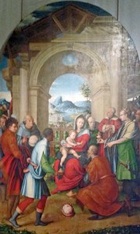
The work was subsequently split into two panels:
-
✴the Visitation; and
-
✴the Adoration of the Magi (illustrated here).
The predella, which had an inscription bearing the date, was subsequently lost.
The two main panels then went their separate ways:
-
✴Dominique-Vivant Denon, the Director of the Musée Napoleon selected the Visitation for confiscation after the Napoleonic suppression of 1810, and it is still in what is now the Musée du Louvre, Paris.
-
✴The Adoration of the Magi remained in Sant' Agostino until 1863, when it entered the Galleria Nazionale.

